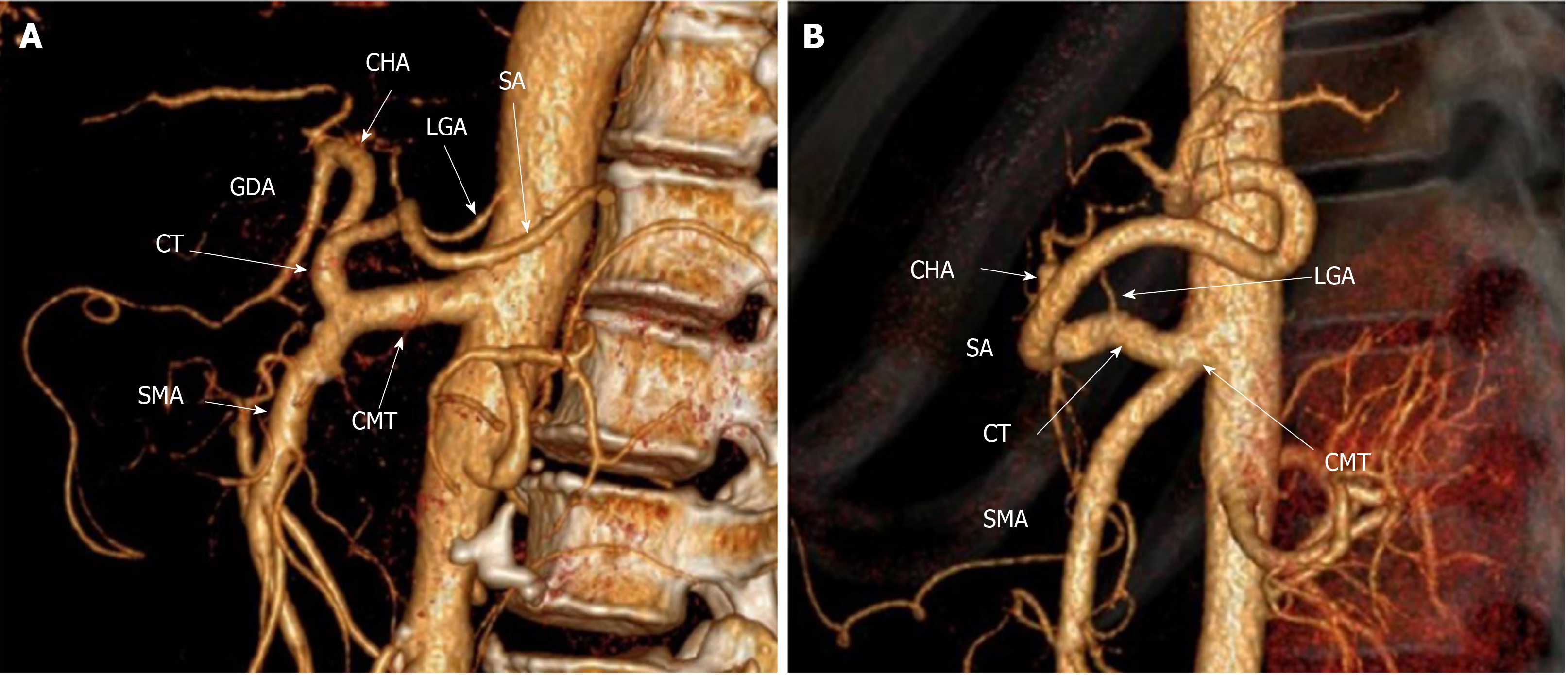Copyright
©The Author(s) 2019.
World J Clin Cases. Dec 6, 2019; 7(23): 3980-3989
Published online Dec 6, 2019. doi: 10.12998/wjcc.v7.i23.3980
Published online Dec 6, 2019. doi: 10.12998/wjcc.v7.i23.3980
Figure 1 Long and short types of celiomesenteric trunk.
A: A long type celiomesenteric trunk (CMT). The celiac trunk (CT) and the superior mesenteric artery (SMA) branch from the single common trunk (CMT) after originating from the aorta and continuing about 28 mm in length in this patient; B: A short type CMT. The CT and the SMA branch from the single common trunk (CMT), which continues for about 9 mm in this patient. CMT: Celiomesenteric trunk; CT: Celiac trunk; SMA: Superior mesenteric artery; LGA: Left gastric artery; CHA: Common hepatic artery; SA: Splenic artery; GDA: Gastroduodenal artery.
Figure 2 Five types of celiomesenteric trunk.
A: Type I, a hepato-gastro-spleno-mesenteric trunk, can be further divided into type Ia-;the left gastric artery (LGA) originating from the celiac trunk; B: Type Ib-;the LGA originating from the single common trunk; C: Type II, a hepato-spleno-mesenteric trunk with LGA arising from the aorta; D: Type III, a gastro-spleno-mesenteric trunk with the common hepatic artery (CHA) arising from the aorta; E: Type IV, a hepato-gastro-mesenteric trunk with the splenic artery (SA) arising from the aorta; F-H: Type V, any other variation that meets the above definition of the celiomesenteric trunk (CMT), for example, a CMT with the LGA originating from the CHA (F) or the SA (G), or a CMT with the CHA arising from the superior mesenteric artery (H). CMT: Celiomesenteric trunk; CT: Celiac trunk; SMA: Superior mesenteric artery; LGA: Left gastric artery; CHA: Common hepatic artery; SA: Splenic artery; GDA: Gastroduodenal artery.
Figure 3 Schematic diagram of embryologic development for normal anatomy and celiomesenteric trunk variants of the celiac trunk and the superior mesenteric artery.
The primitive dorsal abdominal aorta is an origin for four ventral mesenteric roots-;the left gastric artery (LGA), common hepatic artery (CHA), splenic artery (SA), and superior mesenteric artery (SMA). These are joined by a longitudinal anastomosis (arrowheads). A: When the longitudinal anastomosis is interrupted between roots 3 and 4 (dashed line), the normal configuration of the celiac trunk and SMA can be generated; B: Persistence of the longitudinal anastomosis among all four roots may generate a type Ia celiomesenteric trunk (CMT); C: An incomplete interruption between roots 1 and 2 (dashed line) could result in a type Ib CMT, and both types should also be long type CMT; D: An incomplete interruption between roots 3 and 4 (dashed line) could result in a short type CMT; E: Dislocation interruption between roots 1 and 2 (dashed line) may generate a type II CMT. Since the origins of CHA, SA and LGA approximate at the same level, the up and down position among the three arteries may not be invariant; F: If the root 1 is the CHA and a dislocation interruption occurs between roots 1 and 2 (dashed line), a type III CMT would form; G: If the root 1 is the SA, the dislocation interruption (dashed line) would result in a type IV CMT; H: Type V may be due to complete regression or absence of the root 1 (dashed line), a replaced LGA arising from other arteries. CMT: Celiomesenteric trunk; SMA: Superior mesenteric artery; LGA: Left gastric artery; CHA: Common hepatic artery; SA: Splenic artery.
- Citation: Tang W, Shi J, Kuang LQ, Tang SY, Wang Y. Celiomesenteric trunk: New classification based on multidetector computed tomography angiographic findings and probable embryological mechanisms. World J Clin Cases 2019; 7(23): 3980-3989
- URL: https://www.wjgnet.com/2307-8960/full/v7/i23/3980.htm
- DOI: https://dx.doi.org/10.12998/wjcc.v7.i23.3980











